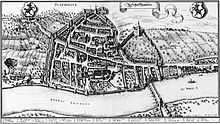Sankt Agnesen Monastery (Schaffhausen)

The Benedictine monastery of Sankt Agnesen in Schaffhausen was founded in 1080 by Burkhard von Nellenburg for his mother Countess Ita († after 1100). Burkhard was the son of Count Eberhard VI. from Nellenburg . This received in 1045 from King Heinrich III. in Cologne the right to mint for Schaffhausen. The monastery, consecrated to Saint Agnes , was the second monastery in the still young city , along with the All Saints monastery founded in 1049 . After the Reformation the nunnery was closed. The buildings were largely used unchanged as a hospital . The facility was taken over by the city of Schaffhausen in 1936 and converted into an old people's home.
From the foundation to the 15th century
Little information has survived from the time it was founded. In 1092 the monastery was subordinated to the abbot of All Saints Monastery. In the 14th century, two fires largely destroyed the original monastery. A new Gothic-style monastery was then built on the same site . It was completed by the end of the 14th century. The monastery area bordered directly on the eastern city wall, in the area of today's Bachstrasse. The houses west of Pfrundhausgasse, such as B. the ox barn belonged to the monastery. The ox barn is now used as the parish center of the Evangelical Reformed Church in Schaffhausen. To the south, the monastery complex extended to today's Pfarrhofgasse and also included the building, which was a fire department store until the beginning of the 1990s. To the north, Repfergasse formed the boundary of the monastery area.
The monastery was headed by a master. Most of the nuns came from the Schaffhausen citizenship or from noble families from nearby Hegau . The monastery enjoyed great popularity. At the beginning of the 14th century, the number of sisters had to be limited to a maximum of 60. Thanks to several foundations and the entrance fees, the monastery finally had extensive property in the area around Schaffhausen and, because of the resulting taxes, had a solid economic base. In the 14th century the hamlet of Gennersbrunn belonged to the monastery. It is said that several nuns helped through foundations to alleviate the need of the poor and the sick.
Dissolution and conversion into a hospital
After the Reformation , the St. Agnesen monastery was closed. At the same time, the other two monasteries in Schaffhausen, the Allerheiligen Monastery and the Barefoot Monastery , were also dissolved. Almost every medieval town had a hospital that welcomed the poor, the sick, the elderly, orphans and the mentally ill. After the dissolution of the nunnery, the council of Schaffhausen decided to move the city hospital from the building that corresponds to today's Posthof to the vacant facilities of the former Sankt Agnesen monastery. The buildings were only slightly adapted and from 1542 served as a poor house , benefice house , orphanage , penitentiary and as a madhouse . The welfare institution was financed by pious foundations and voluntary contributions from citizens.
From the 18th to the 21st century
Because of the generally high mortality rate in the early modern period, orphanages were much more important than they are today. The conditions in the orphanage in Schaffhausen were obviously very bad. The close proximity to the poor house and the breeding facility was also not very beneficial for the healthy development of the children. The taskmaster, who took care of the supervision of the prisoners and their corporal punishment, was also responsible for the school lessons of the orphans.
In 1822 the new orphanage on Rosengasse was inaugurated, which noticeably improved the situation of the orphans. In the following two years, the former monastery and hospital church was structurally changed significantly. The prison was located in the buildings of the former monastery until 1915. The city of Schaffhausen took over the old hospital in 1936 and converted it into an old people's home. The monastery and hospital church, which had already undergone major changes in the past, served as the main building of the old people's home. The dining room was set up in the bed room of the repealed beneficiary house.
In 1960 the buildings of the old people's home were supplemented by a large extension. At the turn of the millennium, the buildings were again adapted to the changed needs of an old people's home. The orphanage, now called the children's and youth home, returned to its old location.
Today the appearance of the building is hardly reminiscent of the former Benedictine monastery of St. Agnesen.
swell
- Andreas Schiendorfer: Gennersbrunn. In: Historical Lexicon of Switzerland .
- City archive of Schaffhausen
- City Archives Schaffhausen: Historical Pictures
- Holdings : Agnesenamt (files of the St. Agnes Monastery and files of the St. Agnesenamt introduced in 1542). State Archives Schaffhausen. link
Coordinates: 47 ° 41 '51.1 " N , 8 ° 38' 11.6" E ; CH1903: 689 922 / 283676




